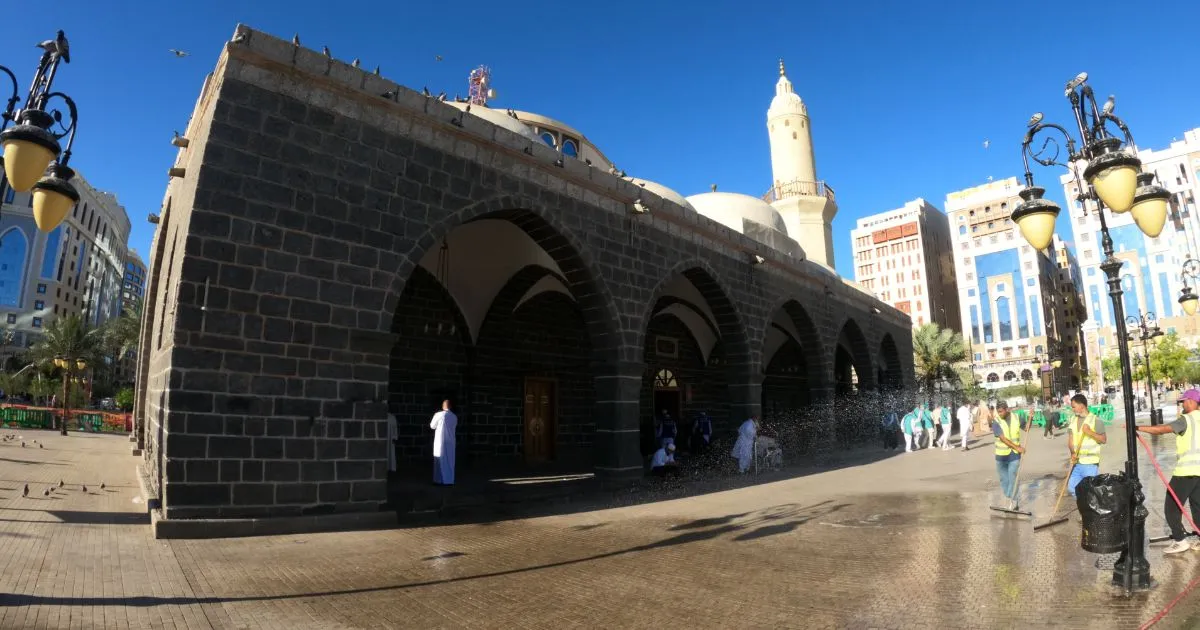Saudi arabia Madinah Traditional architecture is more than history—a blueprint for sustainablity
Table of Contents
Saudi arabia Madinah Traditional architecture is more than history—a blueprint for sustainablity
As you explore the traditional architecture of Madinah, you’ll discover a rich heritage that transcends historical significance. The traditional houses in this ancient city are not just relics of the past but serve as a blueprint for sustainable living in the present.
You will be introduced to the ingenious designs and layouts that have allowed these saudi arabian heritage homes to stand the test of time, providing valuable lessons for modern architecture. The unique blend of cultural, religious, and environmental influences in Madinah’s traditional architecture makes it a fascinating subject for study and inspiration, embodying principles of sustainable ancient architecture.
Key Takeaways
- Traditional houses in Madinah offer insights into sustainable living.
- The layouts of these homes have been designed to withstand the test of time.
- Cultural, religious, and environmental factors influence the architecture.
- These heritage homes provide valuable lessons for modern architecture.
- The traditional architecture in Madinah is a rich heritage worth exploring.
The Rich Heritage of Madinah’s Architectural Legacy
As you explore the architectural heritage of Madinah, you uncover a rich legacy that reflects the city’s historical and cultural significance. This legacy is not just a relic of the past but a living, breathing testament to the city’s enduring values and traditions.
Historical Context of Building Traditions
The historical context of Madinah’s building traditions is deeply rooted in its past as a significant center of trade and Islamic culture. Over the centuries, the city has been influenced by various architectural styles, from the early Islamic period to the Ottoman era. These influences have blended together to create a unique architectural identity that is distinctly Madinah.
The evolution of Madinah’s architecture has been shaped by its geographical location, climate, and the cultural exchange that occurred along the trade routes. This has resulted in the development of building techniques and designs that are adapted to the local environment, ensuring sustainability and harmony with the surroundings.
Cultural and Islamic Influences on Architectural Development
Cultural and Islamic influences have played a pivotal role in shaping the architectural development of Madinah. The city’s status as a holy site in Islam has led to the incorporation of specific design elements that reflect its religious significance. For instance, traditional houses in Madinah often feature The Qa’a (Main Hall), a central reception area that serves as the heart of the home, and The Diwan (Sitting Area), a space designed for social gatherings and family interactions. These elements not only add to the aesthetic appeal of the houses but also embody the social and religious values of the community.
The design of these traditional homes is characterized by a strong emphasis on privacy, family life, and community values, reflecting the broader cultural and Islamic principles that guide daily life in Madinah. As such, the architecture of Madinah is not just about building design; it’s about creating spaces that foster community, respect, and spiritual growth.
Traditional Houses in Madinah: An Overview
The traditional houses of Madinah offer a glimpse into the city’s past, showcasing a unique blend of cultural and geographical influences. As you explore these historic homes, you’ll gain a deeper understanding of the city’s architectural heritage and the factors that have shaped it.
Defining Characteristics of Madinah Homes
Traditional houses in Madinah are characterized by their use of local materials, such as stone and mud brick, which provide insulation against the harsh desert climate. The homes are often designed with thick walls and small windows to minimize heat gain and maximize shade. Additionally, the use of intricate wooden latticework and ornate doorways adds a touch of elegance and sophistication to these historic homes.
The layout of traditional Madinah homes is also noteworthy, with a focus on creating private, family-oriented spaces that are shielded from the outside world. This is achieved through the use of internal courtyards and carefully positioned doorways, which help to maintain a sense of seclusion and tranquility.
Regional Variations Within the City
While traditional houses in Madinah share certain characteristics, there are also regional variations within the city that reflect the diverse cultural and geographical contexts of different areas. For example, homes in the older parts of the city may feature more traditional architectural styles, while those in newer areas may incorporate modern elements and materials.
A comparison of regional variations in traditional Madinah homes is illustrated in the table below:
| Region | Architectural Style | Building Materials |
|---|---|---|
| Old City | Traditional | Stone, mud brick |
| Newer Areas | Modernized traditional | Concrete, stone |
| Rural Areas | Simplified traditional | Mud brick, thatch |
By examining these regional variations, you can gain a deeper appreciation for the complexity and diversity of Madinah’s architectural heritage, including its madinah historical buildings.
The Ingenious Layouts of Traditional Madinah Houses
As you explore the traditional architecture of Madinah, you’ll discover layouts that are both functional and adapted to the harsh desert environment. The traditional houses in Madinah are designed to provide comfort and sustainability, reflecting the ingenuity of their designers.
Spatial Organization Principles
The spatial organization of traditional Madinah houses is centered around creating functional and comfortable living spaces. You will notice that these homes often feature a central courtyard, which serves as a hub for various family activities. This design not only promotes a sense of community but also helps in natural cooling, as the courtyard allows for the circulation of air and provides shade.
The use of thick walls and small windows further aids in maintaining a cooler indoor climate, reducing the need for other cooling methods. This thoughtful design is a testament to the resourcefulness of the architects who built these homes, utilizing the available materials and climate conditions to create sustainable living spaces.
Privacy and Family Life Considerations
Privacy is a significant consideration in the design of traditional Madinah houses. You will observe that these homes are designed with separate areas for different family activities, ensuring that family members can enjoy their private time while still being part of the family unit. The layout often includes designated spaces for receiving guests, which are separated from the rest of the living areas to maintain privacy.
Moreover, the incorporation of multi-purpose rooms and service units enhances the functionality of these homes. These spaces can be used for various purposes, from storage to additional living areas, making the homes adaptable to the changing needs of the family.
Seasonal Adaptations in Home Layout
Traditional Madinah houses also show adaptations to the seasonal changes in the desert climate. For instance, some homes feature rooftop areas that are used during the cooler months for sleeping or socializing. The design of these homes takes into account the extreme temperatures of the desert, providing cooler spaces during the hot summer months and warmer areas during the cooler winter months.
Furthermore, the use of vertical movement elements like staircases not only connects different levels of the house but also plays a role in the ventilation and cooling of the home. The strategic placement of staircases can help in creating a cooling effect by facilitating the movement of cooler air from lower to upper levels.
| Design Element | Purpose | Benefit |
|---|---|---|
| Central Courtyard | Hub for family activities and air circulation | Promotes community and natural cooling |
| Thick Walls and Small Windows | Reduce heat gain and maintain cooler indoor climate | Enhances comfort and reduces cooling needs |
| Separate Areas for Family Activities | Maintain privacy and accommodate different activities | Enhances family life and guest reception |
| Multi-Purpose Rooms and Service Units | Provide adaptable spaces for various needs | Increases the functionality and flexibility of the home |
Key Elements of a Traditional Madinah House
You can gain a deeper understanding of traditional Madinah architecture by examining the key elements that define these homes. At the heart of a traditional Madinah house lies The Qa’a, or Main Hall, which serves as a central space for family and social gatherings. This area is often lavishly decorated and designed to accommodate guests, showcasing the hospitality that is characteristic of the region.
The Diwan, or Sitting Area, is another crucial element, providing a comfortable space for relaxation and socialization. The design and layout of The Diwan are carefully considered to promote a sense of community and togetherness. In addition to these key areas, traditional Madinah houses often feature Vertical Movement Elements, such as staircases, and Multi-Purpose and Service Units, which contribute to the functionality and elegance of the home.
As you explore the traditional architecture of Madinah, you will appreciate the sophistication and elegance that these elements bring to the overall design of the house. The incorporation of these features not only reflects the cultural and Islamic influences on the region’s architectural development but also demonstrates a keen understanding of the need for functional and beautiful spaces.
FAQ
What are the main characteristics of traditional architecture in Madinah?
The traditional architecture in Madinah is characterized by its unique blend of cultural, religious, and environmental influences, making it a fascinating subject for study and inspiration. You can observe the incorporation of natural cooling techniques suited to the desert climate, as well as the consideration for privacy and family life in the design of these homes.
How do traditional Madinah houses adapt to the desert climate?
Traditional Madinah houses are designed to adapt to the desert climate through the use of natural cooling techniques, such as thick walls and shaded areas, which help to reduce the temperature inside the house. You can also see the incorporation of elements like wind catchers and mashrabiyas to enhance ventilation and cooling.
What is the significance of The Qa’a (Main Hall) in a traditional Madinah house?
The Qa’a (Main Hall) is a central space in a traditional Madinah house, serving as a gathering area for family and social events. You will find that it is often designed with elegance and sophistication, reflecting the social and cultural values of the community.
How do regional variations within Madinah impact the design of traditional houses?
Regional variations within Madinah have influenced the design of traditional houses, resulting in a rich tapestry of architectural styles. You can observe how different regions have incorporated their unique cultural and geographical contexts into the design of their homes, reflecting the diversity of Madinah’s architectural heritage.
What role do Vertical Movement Elements (Staircases) play in traditional Madinah houses?
Vertical Movement Elements (Staircases) are an essential feature in traditional Madinah houses, providing access to different levels of the home. You will notice that they are often designed with functionality and aesthetics in mind, contributing to the overall character of the house.
How do traditional Madinah houses incorporate sustainable ancient architecture?
Traditional Madinah houses incorporate sustainable ancient architecture through the use of local materials, natural cooling techniques, and clever design elements. You can see how these features have allowed these structures to stand the test of time, providing valuable lessons for modern architecture and sustainable living.
What can we learn from the layouts of traditional Madinah houses?
The layouts of traditional Madinah houses offer valuable insights into spatial organization, privacy, and seasonal adaptations. You can learn how to create functional and comfortable living spaces that are adapted to the local climate and cultural context, making them relevant to modern architectural design.

